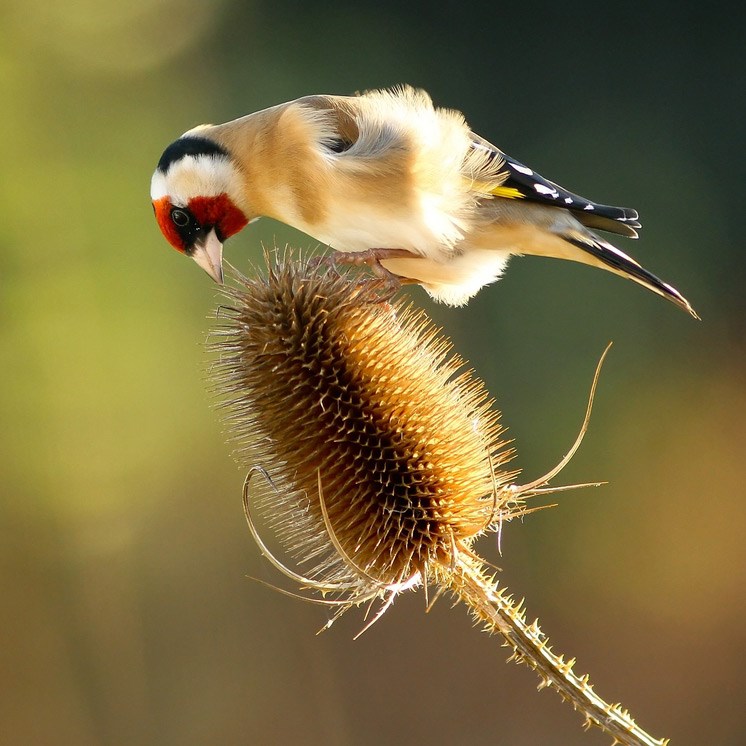
This much-loved biennial produces rose-purple or white thistle-like flowerheads, which top the long stems in July and August. It adds a structural element to planting, and is perfect for a sunny wildflower border or wildlife garden where it will act as a magnet to bees and goldfinches, which love to feast on the seedheads. These seedheads also dry really well, so will make handsome additions to everlasting arrangements in the home. Commonly known as teasel, its name refers to the spiny heads that were once used for raising or 'teasing out' the nap on fabrics.
How to care for Dipsacus fullonum:
Gather flower-heads for use in dried flower arrangements from mid- to late summer before the seedheads begin to ripen. Do make sure you leave some for the birds however - and still have some to scatter their seed, which will ensure a new batch of seedlings in the following year.
Sowing instructions:
Direct-sow shallowly in spring into a well- prepared bed and when the seedlings start to appear, thin to 30cm intervals. Alternatively, start them off in trays and harden off before planting out. Keep well watered. These plants self-seed freely, which is great if you have a large area to colonise. If you do not want more, cut back the plants before they set seed.
Flowering period:
- Jan
- Feb
- Mar
- Apr
- May
- Jun
- Jul
- Aug
- Sep
- Oct
- Nov
- Dec
Eventual height:
1m
Eventual spread:
0.5m
Position:
Full sun / light shade
Rate of growth:
Fast-growing
Soil:
Moderately fertile, moist, well-drained soil
Hardiness:
Fully hardy
-
This perennial dies back to below ground level each year in autumn, then fresh new growth appears again in spring.
Product options

9cm pot
£7.99
In stock
(shipped within 2-3 working days)
(shipped within 2-3 working days)

3 × 9cm pots
£18.99
£6.33 each
In stock
(shipped within 2-3 working days)
(shipped within 2-3 working days)

6 × 9cm pots
£34.99
£5.83 each
In stock
(shipped within 2-3 working days)
(shipped within 2-3 working days)

approx 150 seeds
£2.99
In stock
(shipped within 2-3 working days)
(shipped within 2-3 working days)
1
Delivery options (pick your preferred option at checkout)
Standard Delivery£5.99
Named Day Delivery£10.99

This much-loved biennial produces rose-purple or white thistle-like flowerheads, which top the long stems in July and August. It adds a structural element to planting, and is perfect for a sunny wildflower border or wildlife garden where it will act as a magnet to bees and goldfinches, which love to feast on the seedheads. These seedheads also dry really well, so will make handsome additions to everlasting arrangements in the home. Commonly known as teasel, its name refers to the spiny heads that were once used for raising or 'teasing out' the nap on fabrics.
How to care for Dipsacus fullonum:
Gather flower-heads for use in dried flower arrangements from mid- to late summer before the seedheads begin to ripen. Do make sure you leave some for the birds however - and still have some to scatter their seed, which will ensure a new batch of seedlings in the following year.
Sowing instructions:
Direct-sow shallowly in spring into a well- prepared bed and when the seedlings start to appear, thin to 30cm intervals. Alternatively, start them off in trays and harden off before planting out. Keep well watered. These plants self-seed freely, which is great if you have a large area to colonise. If you do not want more, cut back the plants before they set seed.
Flowering period:
- Jan
- Feb
- Mar
- Apr
- May
- Jun
- Jul
- Aug
- Sep
- Oct
- Nov
- Dec
Eventual height:
1m
Eventual spread:
0.5m
Position:
Full sun / light shade
Rate of growth:
Fast-growing
Soil:
Moderately fertile, moist, well-drained soil
Hardiness:
Fully hardy
-
This perennial dies back to below ground level each year in autumn, then fresh new growth appears again in spring.
Product options

9cm pot
£7.99
In stock
(shipped within 2-3 working days)
(shipped within 2-3 working days)

3 × 9cm pots
£18.99
£6.33 each
In stock
(shipped within 2-3 working days)
(shipped within 2-3 working days)

6 × 9cm pots
£34.99
£5.83 each
In stock
(shipped within 2-3 working days)
(shipped within 2-3 working days)

approx 150 seeds
£2.99
In stock
(shipped within 2-3 working days)
(shipped within 2-3 working days)
1
Delivery options (pick your preferred option at checkout)
Standard Delivery£5.99
Named Day Delivery£10.99
